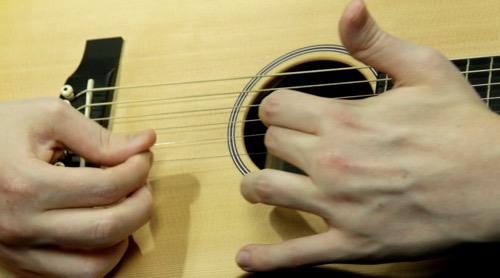The Soundhole Scratch

Hi, this is Hub Guitar.
I want to give you an introduction to what I think is a really cool special effect. It works especially well when you're playing some high notes past fret XII of the high E or B string. You an actually keep going all the way up the string over the soundhole and keep picking. You'll get some interesting harmonics. if you press down on the string, you can alter the pitches of he harmonics.�
Let me give you an example.
Alright, so you start by putting your left hand finger gently on the e and b strings over the sound hole.
You can alter the pitch by pushing down on the string, or reducing the pressure if you've already pushed down.�
You can apply some rhythmic picking patterns.
Interestingly, you can also play a chromatic scale. No chart of diagram is really going to help you here; if you want to do this, you'll have to choose a starting note and do it by ear. Of course, you can play fretted notes to compare and help you figure out if you're on the right track or not.
Those are just a few of the things you can do with this technique. I hope you will explore this technique and apply it into your playing, because only a few players are using this one and I want to hear alot more of it in the coming years.�
Soundhole scratching is a fairly uncommon technique. The fretting hand moves up the fretboard past the last fret and above the soundhole. The high “e” string is the best for this. The string is continually picked, usually rapidly, but the pitches of the string are not quite exact. They are vague and full of harmonics. But by pushing the string down and moving further up the string, the harmonics can be altered. The result is a really cool effect—if you don’t overuse it. Each note does correspond to a specific pitch, so you can also practice chromatic scales or other patterns this way. However, since there are no frets, it is difficult to play pitches accurately and the result can also end up being somewhat microtonalLoosely speaking, a musical system dividing the octave into more than 12 notes. .
Flamenco grandmaster Paco de Lucía sometimes played using this effect. It can also be heard in the hands of French guitar player Biréli Lagrène, among others.
Step-By-Step
Put your fret-hand finger on the string
Put your fret-hand finger on the high “e” string, above the soundhole. It may be necessary to push down on the string a little bit to start hearing a pitch.
Pluck the string
With the picking hand, pluck the string. You can also try using tremolo picking here.
Adjust the pitch of the string
You can increase the pitch of the string by pushing down harder on it, or by moving closer to the guitar bridge.
Play a chromatic scale
See if you can hear the notes of a chromatic scale in your head and try to follow along. With some practice, you can create a series of notes similar to a chromatic scale.
 As the creator of Hub Guitar, Grey has compiled hundreds of guitar lessons, written several books, and filmed hundreds of video lessons. He teaches private lessons in his Boston studio, as well as via video chat through TakeLessons.
As the creator of Hub Guitar, Grey has compiled hundreds of guitar lessons, written several books, and filmed hundreds of video lessons. He teaches private lessons in his Boston studio, as well as via video chat through TakeLessons.